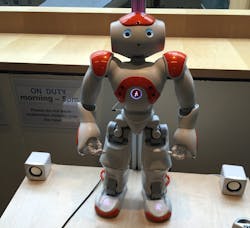As we talk more and more about the Internet of Things (IoT) and what it can bring to industry, one of the points that have been made is that much of the technology involved has been around for many years. What brings it to the forefront now is that manufacturers are able to take more advantage of those capabilities and make better sense of all the data coming off those increasingly interconnected devices.
Like those devices always running in the background, Microsoft—ubiquitous in industry for decades—is upping its visibility in the manufacturing sector, highlighting its capabilities in the Industrial IoT (IIoT) space and showing off real-world applications with partners like KUKA Robotics, Fujitsu and ThyssenKrupp using the cloud computing platform Microsoft Azure.
“It’s the start of a new era. It’s nothing short of a revolution,” said Caglayan Arkan, general manager of worldwide manufacturing and resources for Microsoft. “We’re looking at businesses and industries, and we’re saying industry will be remade.”
The technologies bringing it all to the fore include virtually unlimited compute power, Arkan said, along with things like augmented reality, natural user interfaces and machine learning. “All of this will create systems of intelligence,” he said. “In this new era, Microsoft’s role is empowering individuals and organizations across any vertical, any geography, any size to achieve more.”
Arkan talked to a dozen or so trade journalists gathered last week at Microsoft’s campus in Redmond, Wash., about Fujitsu’s projects for the perfect lettuce and the connected cow. But he also pointed to the work going on in the automotive industry. “Those cars are now smarter than ever,” he said, talking about identifying patterns, preventing failures, maybe even preventing recalls in the future. “Five, seven, eight years from now, that industry will not look like what it is today.”
Mass production has been very capital-intensive, but that will change, Arkan said. “That happened in an era of limited automation investments. A lot of tasks are still done manually, and there’s very little flexibility. Now with increased levels of automation…we’re looking at a world where one size fits one is real.”
Two features in Automation World’s May and June issues have focused specifically on human-robot interaction and the increasingly ability to let robots operate alongside humans and outside of their traditional safety confines. Arkan spoke also of Microsoft’s work with KUKA Robotics, and robots becoming more intelligent.
“What the robot does today, it learns if you’re approaching. If you put your hand in front of where you’re trying to reach, it stops,” Arkan said. “If it comes from a wrong angle, it kind of wiggles. And while this one learns, tens of thousands of robots around the world can learn at the same time.”
Industry 4.0 (a.k.a. the Internet of Things) is behind so much of the innovation that’s going on in industry right now, Arkan indicated, and “pretty much every early adopter is becoming a software company,” he added. “Those companies are paving the way and then making real things in real environments with real impact. Others will have to follow because they will feel like they’re staying behind.”
Much of the innovation that Microsoft had to show off last week was for retail and financial customers, a separate cybercrime presentation also geared more toward the consumer side of the business. But just as the bring-your-own-device (BYOD) movement has shown, workers are keen to be able to apply the consumer technologies that they’ve come to take for granted at home to their industrial environs. It’s not too difficult to see how what helps banks and retail outlets be more efficient can work for factories and oil operations as well.
Susan Hauser, corporate vice president of Microsoft’s Enterprise and Partner Group, talked about several trends related in particular to retail, but most of it related to manufacturing as well—leveraging Skype to bring in needed expertise, changing employee skillsets, project trials, and increasing operation from the cloud.
About cloud computing, she said, “Years ago, it was a little of ‘Well, maybe.’ Now it’s ‘How and with whom? Where do I get started?’” The best place to start, she added, is where you can easily show a return.
“We strongly believe it is a hybrid approach,” Hauser said, explaining the mix of public and private clouds, with some things staying on premise. “What’s important is the intelligence of the data layer that sits across the cloud. What’s really important is how do you extract the value back to the business?”
Showing value is key for any new project, and IoT implementation is certainly no exception. As Microsoft tries to solve problems for its customers, it’s important to keep trials short—typically trying to complete projects within an eight-week timeframe, Hauser said. “We’re chunking it out to bring value back to the business faster,” she said. “We need to see that this is really going to have an impact. We need to see a proof of concept in eight weeks.”
In the oil and gas industry, for example, Microsoft is working with automation companies like Rockwell Automation, using predictive analytics to determine where to drill, Hauser said. “We’re at the tip of the iceberg of the results that we can see.”
IoT is offering more opportunities than ever in the way of optimizing processes. “One of the notions that I like is this notion of optimization: Optimizing the part will always suboptimize the whole,” Arkan said. “For the first time in history, optimizing the whole will be possible. You will have visibility of your business at a global level. You will have visibility of everything. We can monitor, predict, run analytics, make decisions, control and optimize. That is what Industry Revolution 4.0 is.”
About the Author
Aaron Hand
Editor-in-Chief, ProFood World

Leaders relevant to this article:
